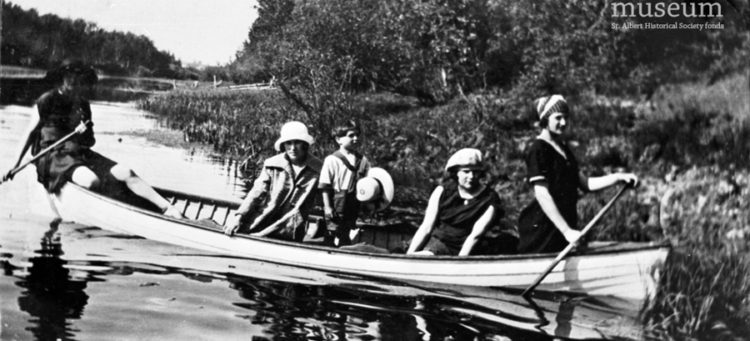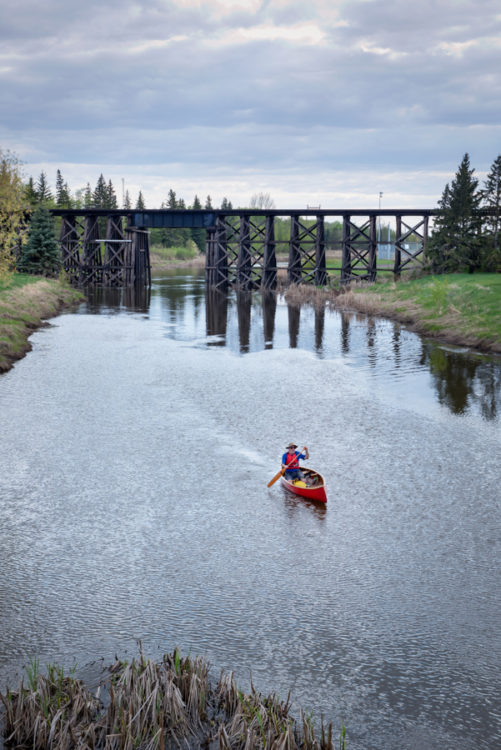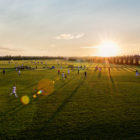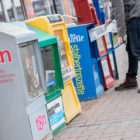
Then & Now
Sturgeon River: A River Runs Through It - Winding through the history of the Sturgeon waterway
July, 2019
Just as it flows 260 km from its headwaters at Hoople Lake south of Entwistle to its confluence with the North Saskatchewan, the Sturgeon River also flows through 150 years of St. Albert history. Much has changed over those years, but in many ways the Sturgeon remains the (slow) beating heart of the city. Now, with growing public interest in its conservation, one can hope the river will experience a renaissance in the decades to come.
Early History
According to the Geographic Board of Canada’s 1928 Place-names of Alberta, the river’s original name was derived from the Cree word mihkwapemak, meaning “red willow.” European explorers would quickly rename it for “the abundance of sturgeon caught in the river.” Indeed, this fishier appellation appears as early as David Thompson’s 1814 map of the region.
In 1862, a year after the settlement’s founding, heavy spring run-off inspired Father Lacombe to build a bridge—the first in Canada west of the Great Lakes—following mass one Sunday. The locals, many of whom had never seen a bridge before, entertained themselves by repeatedly crossing the completed 300-foot span, which was wide enough for an ox-cart to cross.
From the beginning, the river was the go-to spot for fun and games. In summer, it was swimming, fishing, and canoeing, while winter saw weekend skating and hockey. In 1914, the paddlewheeler Ste. Thèrésa began making Sunday and holiday excursions between St. Albert and Big Lake. Dropping water levels made the route untenable after a few years, and the boat was moved to Lac Ste. Anne.
The 1940s and 1950s
Being a prairie river, spring run-off sometimes brought the water to precipitous levels. Floods were recorded in 1940, 1943, and 1948, with the last of these described as “extensive.” Outside of spring, however, the river was becoming noticeably sluggish, and in 1956 its flow dropped to nil. Additional water was brought in from Big Lake a year later through a “blasting” process. Though apparently a success, it was not enough to secure the water supply, and the city instead chose to connect with Edmonton’s water supply.
The 1960s and 1970s

Writing in the Gazette in 1962, Eugene Perron described the Sturgeon as “now a sluggish, weedy stream, clogged with silt and beautiful only when seen at a distance or with the sun shining on it.” Harsh, but his words pointed to a growing awareness that decades of neglect and overuse have degraded the Sturgeon. In the early ’70s, Paul Kane students reporting on pollution in the river placed the blame on the sewage lagoons and the town dump. Mayor William Veness remarked at the time that he had never “seen so much interest in the river.”
The Sturgeon continued providing rowdy winter fun, though. In 1970 the RCMP detachment got its first “power toboggan” to help deal with noise complaints arising from snowmobiles on the frozen river late at night. That same winter a skate-a-thon was held to raise money for an artificial ice plant for a new community arena. Close to 500 skaters participated, including Lt. Gov. Grant MacEwan and Mayor Ray Gibbon. Twelve-year-old Stephen Lister skated 80 laps, the most of anyone that day, and the event raised $6,500.
The 1980s and 1990s
Efforts to conserve and beautify the river valley intensified in the ’80s. In 1984, the Devonian Foundation donated money to the city to build riverside trails between the trestle bridge and St. Albert Place. In 1991, the Red Willow Urban Park Master Plan initiated further development, with 85 kms of trail connecting parks and neighbourhoods. That same year, the Big Lake Environment Support Society (BLESS) was formed with a mandate to conserve the Big Lake wetlands. BLESS would later play a prominent role in the contentious fight over the west bypass, which would eventually become Ray Gibbon Drive near where the Sturgeon flows out of Big Lake.
Today
Things have improved somewhat for the Sturgeon. The 2012 Sturgeon River State of the Watershed Report assessed the river’s overall health as “fair,” stressing the continued need to minimize the impact of urbanization and the loss of natural areas, as well as reducing the amount of pollution entering the water. What is clear is that much work remains to ensure the health of this important waterway so that future St. Albertans can continue to enjoy it. t8n













